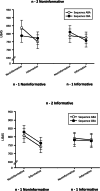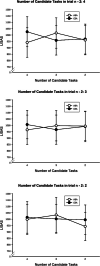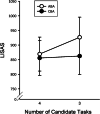Inhibition during task switching is affected by the number of competing tasks
- PMID: 37698800
- PMCID: PMC10805815
- DOI: 10.3758/s13421-023-01456-w
Inhibition during task switching is affected by the number of competing tasks
Abstract
Inhibition during task switching is assumed to be indexed by n - 2 repetition costs-that is, performance costs when the task in the current trial equals the task in trial n - 2 (sequences of type ABA) compared with two consecutive switches to another task each (sequences CBA). The present study examined effects of a short-term reduction of the number of candidate tasks on these costs. For this purpose, a variant of the task switching paradigm was used in which in half of the trials, a precue that preceded the task cue allowed for a short-term reduction of the number of candidate tasks. In Experiment 1, one out of three tasks could be excluded. In Experiment 2, one or two out of four tasks could be excluded. Experiment 3 served as control condition using the standard cueing paradigm. Significant n - 2 repetition costs were present with three candidate tasks. In contrast, no costs were visible when the number of candidate tasks was reduced to two. This result is interpreted in terms of a task selection mechanism based on antagonistic constraints among task representations, which operates on a rather superficial level when switching among only two tasks, thereby reducing the need for inhibition.
Keywords: Inhibition; N – 2 repetition costs; Task switching.
© 2023. The Author(s).
Conflict of interest statement
The authors declare that they have no conflict of interest.
Figures






Similar articles
-
Inhibition of cued but not executed task sets depends on cue-task compatibility and practice.Psychol Res. 2024 Oct;88(7):2036-2058. doi: 10.1007/s00426-024-02013-z. Epub 2024 Jul 30. Psychol Res. 2024. PMID: 39080024 Free PMC article.
-
Task switching among two or four tasks: effects of a short-term variation of the number of candidate tasks.Psychol Res. 2015 Jan;79(1):163-73. doi: 10.1007/s00426-013-0532-6. Epub 2013 Dec 13. Psychol Res. 2015. PMID: 24337943
-
The role of inhibition in task switching: a review.Psychon Bull Rev. 2010 Feb;17(1):1-14. doi: 10.3758/PBR.17.1.1. Psychon Bull Rev. 2010. PMID: 20081154 Review.
-
Examining binding effects on task switch costs and response-repetition effects: Variations of the cue modality and stimulus modality in task switching.Atten Percept Psychophys. 2020 May;82(4):1632-1643. doi: 10.3758/s13414-019-01931-0. Atten Percept Psychophys. 2020. PMID: 31820281
-
No-go trials in task switching: effects on the task-set and task-space level.Psychol Res. 2022 Jun;86(4):1097-1107. doi: 10.1007/s00426-021-01566-7. Epub 2021 Jul 31. Psychol Res. 2022. PMID: 34333697 Free PMC article.
Cited by
-
Inhibition of cued but not executed task sets depends on cue-task compatibility and practice.Psychol Res. 2024 Oct;88(7):2036-2058. doi: 10.1007/s00426-024-02013-z. Epub 2024 Jul 30. Psychol Res. 2024. PMID: 39080024 Free PMC article.
References
-
- Arbuthnott KD. The influence of cue type on backward inhibition. Journal of Experimental Psychology: Learning, Memory, and Cognition. 2005;31(5):1030–1042. - PubMed
-
- Dreisbach G, Haider H. How task representations guide attention: Further evidence for the shielding function of task sets. Journal of Experimental Psychology: Learning, Memory, and Cognition. 2009;35(2):477–486. - PubMed
-
- Dreisbach G, Wenke D. The shielding function of task sets and its relaxation during task switching. Journal of Experimental Psychology: Learning, Memory, and Cognition. 2011;37:1540–1546. - PubMed
Publication types
MeSH terms
LinkOut - more resources
Full Text Sources

